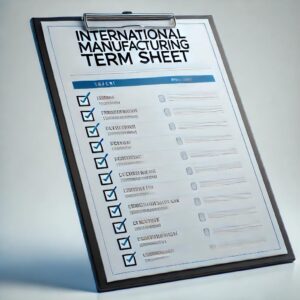President Trump’s Just Announced Tariffs on Products from Canada, Mexico, and China
This blog post is intended to provide the latest information and analyze the potential implications of newly proposed tariffs by President-elect Donald Trump on imports from the United States’ three largest trading partners—Canada, Mexico, and China. My aim is to assess what might likely happen and help businesses prepare for possible changes.
Overview of the Proposed Tariffs
President-elect Donald Trump announced yesterday his plan to implement a 25% tariff on all goods imported from Canada and Mexico, and an additional 10% tariff on imports from China, which would effectively raise most Chinese import tariffs to 35%
Per President Trump, these moves are to address the flow of illegal drugs, particularly fentanyl, and the management of migration across U.S. borders.
Immediate Reactions and Pushback
The announcement has triggered immediate pushback from the affected nations.
- China: Chinese officials have denounced what they see as the beginning of a new trade war against China claiming that such conflicts benefit no one. They also sought to refute the accusations regarding China’s role in fentanyl trafficking.
- Mexico: Mexican authorities warned that these tariffs could lead to a cycle of retaliatory tariffs, putting major businesses like General Motors and Ford at risk, potentially exacerbating U.S. inflation and job losses.
- Canada: Canadian representatives expressed concerns about the negative impact the tariffs on Canadian products will have on jobs in both Canada and the United States, based largely on the integrated nature of North American trade.
My perspective: Around 40 percent of the value of Mexico’s exports to the United States consists of parts and components made at American plants, and the percentage for Canada is likely even higher. The number for China is only 4 percent. This is based on a 2010 report and I think it reasonable to assume that the percentages representing the value of U.S.-manufactured components in Mexican and Canadian exports have increased since 2010, while the percentage for China may have decreased.
These numbers mean that products made in and bought from Mexico and Canada contribute roughly TEN times more money and jobs to the United States than products made in and bought from China.
These economic realities will likely influence which of these proposed tariffs are ultimately implemented.
Today, I invested in General Motors and a Mexico-focused fund, to try to capture potential gains should the proposed tariffs against Canada and Mexico not materialize.
The Economic Implications
Tariffs, essentially taxes on imported goods, are used by countries to control trade volumes, protect domestic industries, or respond to foreign policy challenges. While they can increase government revenue, they also tend to raise prices for consumers, disrupt supply chains, and provoke trade partners to impose counter-tariffs.
My perspective: I believe that President Trump is threatening tariffs against Mexico and Canada in an effort to compel these two countries to make a big effort to slow immigration before he takes office. It is surprising that President Trump has attributed the tariffs against China to issues with fentanyl rather than China’s extensive history of unfair trade practices.
Over the last few months, both Canada and Mexico have done a lot to reduce immigration to the United States and I expect both countries will continue their efforts to reduce immigration up until President Trump’s inauguration. Based on these efforts, I predict that Mexico and Canada may sufficiently address U.S. concerns to prevent the imposition of tariffs.
Despite longstanding commitments, China’s efforts to reduce fentanyl exports to the United States have seen minimal progress. With the inauguration approaching, it appears unlikely that China will undertake sufficient measures to prevent President Trump from implementing the planned 10% additional tariffs on Chinese goods. This decision reflects broader concerns, including China’s persistent shortcomings in adhering to fair trade practices and fulfilling prior trade agreements. Notably, China has fallen short of fulfilling its pledge to purchase $200 billion in U.S. goods under a previous trade deal, managing only to reach approximately $80 billion, thus exacerbating trade tensions.
Historically, President Trump has used tariff threats as strategic leverage in negotiations, aiming to secure more favorable terms for the U.S. In his first term he would often initially propose high tariffs, only to later reduce or remove them as part of broader negotiation strategies. During his first term, he threatened high tariffs on Canada and Mexico but softened his stance after both countries adjusted their practices to better align with U.S. demands. He did impose high tariffs against China, however.
Trump’s Previous Trade Deal with China: Promises vs. Reality
During Trump’s first administration, a major trade deal with China was brokered, wherein China promised to buy $200 billion more in U.S. goods over two years to reduce the trade imbalance. However, the reality fell short of these promises. China’s purchases amounted to only about $80 billion, far below the $200 billion target set by the trade agreement. This shortfall has contributed to heightened tensions between the U.S. (particularly President Trump) and China.
My perspective: My contacts in Washington tell me that President Trump has not forgiven (and will never forgive) China for not fulfilling the promises they made to him about their purchases of American products.
Fentanyl and the Drug Crisis
The issue of fentanyl trafficking has been a particularly poignant aspect of Trump’s campaign against China. Despite China’s decade-long promises to crack down on fentanyl exports, little progress has been made. Critics argue that China benefits financially from the trade in synthetic opioids and sees strategic value in the ongoing drug crisis in the West.
My perspective: This is a powerful political issue and President Trump will likely play this card until such time as the fentanyl problem is no longer an issue in the United States.
Conclusion
President Trump’s tariff announcement marks a critical turning point in U.S. trade policy, with far-reaching implications for supply chains, global trade relations, and economic diplomacy. Stay tuned….

























